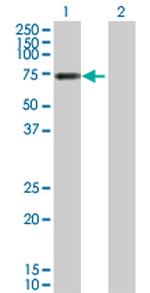Search Thermo Fisher Scientific
FIGURE: 1 / 1
VTN Antibody (H00007448-D01P) in WB
Lane 1: VTN transfected lysate(54.30 KDa).
Lane 2: Non-transfected lysate.

Product Details
H00007448-D01P
Species Reactivity
Host/Isotype
Class
Type
Immunogen
Conjugate
Form
Concentration
Purification
Storage buffer
Contains
Storage conditions
Shipping conditions
Product Specific Information
Sequence of this protein is as follows: MAPLRPLLIL ALLAWVALAD QESCKGRCTE GFNVDKKCQC DELCSYYQSC CTDYTAECKP QVTRGDVFTM PEDEYTVYDD GEEKNNATVH EQVGGPSLTS DLQAQSKGNP EQTPVLKPEE EAPAPEVGAS KPEGIDSRPE TLHPGRPQPP AEEELCSGKP FDAFTDLKNG SLFAFRGQYC YELDEKAVRP GYPKLIRDVW GIEGPIDAAF TRINCQGKTY LFKGSQYWRF EDGVLDPDYP RNISDGFDGI PDNVDAALAL PAHSYSGRER VYFFKGKQYW EYQFQHQPSQ EECEGSSLSA VFEHFAMMQR DSWEDIFELL FWGRTSAGTR QPQFISRDWH GVPGQVDAAM AGRIYISGMA PRPSLAKKQR FRHRNRKGYR SQRGHSRGRN QNSRRPSRAM WLSLFSSEES NLGANNYDDY RMDWLVPATC EPIQSVFFFS GDKYYRVNLR TRRVDTVDPP YPRSIAQYWL GCPAPGHL
Target Information
VTN is a member of the pexin family. This protein is found in serum and tissues and promotes cell adhesion and spreading, inhibits the membrane-damaging effect of the terminal cytolytic complement pathway, and binds to several serpin serine protease inhibitors. The protein is a secreted protein and exists in either a single chain form or a clipped, two chain form held together by a disulfide bond.
For Research Use Only. Not for use in diagnostic procedures. Not for resale without express authorization.
References (0)
Bioinformatics
Protein Aliases: complement S-protein; epibolin; S-protein; serum spreading factor; Serum-spreading factor; somatomedin B; V75; Vitronectin; VN
Gene Aliases: V75; VN; VNT; VTN
UniProt ID: (Human) P04004
Entrez Gene ID: (Human) 7448

Performance Guarantee
If an Invitrogen™ antibody doesn't perform as described on our website or datasheet,we'll replace the product at no cost to you, or provide you with a credit for a future purchase.*
Learn more
We're here to help
Get expert recommendations for common problems or connect directly with an on staff expert for technical assistance related to applications, equipment and general product use.
Contact tech support
